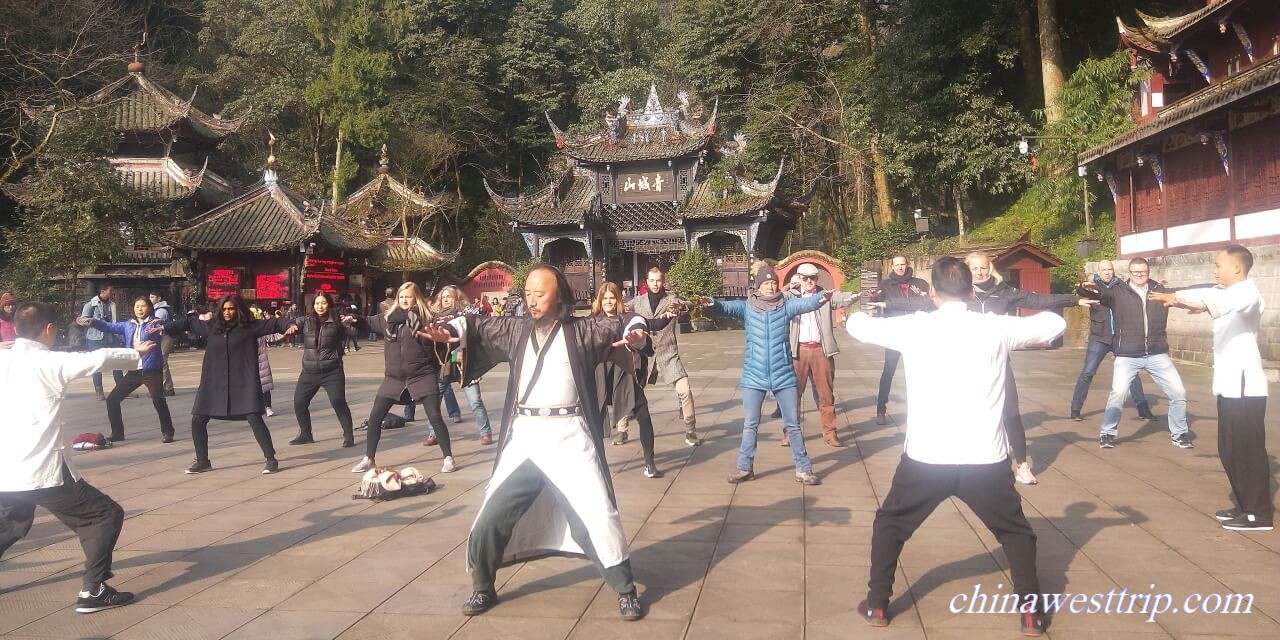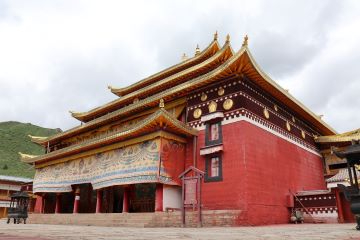Qingcheng Mountain

Name in Chinese: 青城山 Qīng Chéng Shān [tʃin tsən sæ]
Duration of Tour: Half a day
Highlights: Taoist temples and Hiking
Reputations: A World Cultural Heritage Site, A National Five-star Scenic Area, A State-level Key Historical and Cultural Relic Site under Protection
Qingcheng Mountain is situated in the northwest of Chengdu plain, around 65 km(40 miles) away from downtown Chengdu. The name Qingcheng means “green city”. The mountain has 36 peaks. It is named as “green city”, because some of its green cliffs are shaped like city walls. The multi-peaked mountain rises up to 1,600 meters(5249 feet) and has a high rate of vegetation coverage. The mountain is well-known in China for its unique beauty which is called “You” in Chinese. There is no appropriate word or expression in English for this Chinese word “You”. It is used to refer to a tranquil and beautiful place where a zigzag path fades in secluded woods, flowers emit faint fragrance, and singing birds play a delightful chord with murmuring streams.
As the birthplace of Taoism, the native religion of China, Mount. Qingcheng was listed as a world cultural heritage site by UNESCO in 2001. It is rich in Taoist culture. As early as in the Eastern Han Dynasty, Zhang Daoling(34-156) came to Sichuan, and founded the Chinese native religion, Taoism. The mountain used to be the place where he practiced and cultivated his Taoism. Taoist doctrine was built on the ancient witchcraft, recipes for immortality, and the concepts of Huangdi(Yellow Emperor) and Laozi. Taoists believe that all things in the universe have their own spirits(gods). The Taoist gods are supposed to live far away in their ten celestial caverns and 72 happy lands. Mount. Qingcheng is known as the No.5 celestial cavern. Why was Qingcheng Mountain chosen as a celestial cavern? It is probably because of its unique beauty, the so-called “You”. It is just considered as a kind of land where gods live.
Qingcheng Mountain consists of two parts, the Front Mountain and the Back Mountain. The Front Mountain is usually referred to as Qingcheng Mountain, because it is the birthplace of Taoism, more famous than the Back Mountain. This article focuses on the Front Mountain. If you are interested in the Back Mountain, please contact us for more information.
Panda Village in Kung Fu Panda Movies
Qingcheng Mountain features prominently in the movie Kung Fu Panda 2. In order to get inspiration for the 3-D movie Kung Fu Panda 2, the director Jennifer Yu Nelson came to Qingcheng Mountain with her team. She was completely moved by the beauty of Qingcheng Mountain. She located the Panda Village in Qingcheng Mountain in Kung Fu Panda 2. She said that Mount. Qingcheng was a source of inspiration for the Panda Village in Kung Fu Panda 2; the village was special to Po in his whole life; it was the place where he met his father and other pandas.
Qingcheng Tai Chi Boxing
Tai Chi Boxing was created by a Taoist master, Zhang Sanfeng. Zhang Sanfeng was born in 1247. He lived in Wudang Mountain, Hubei Province. There are several schools and styles of Tai Chi Boxing in China, like Wudang Tai Chi, Chen’s Tai Chi, Yang’s Tai Chi, and Qingcheng Tai Chi. Qingcheng Tai Chi is also known as Xuanmen Tai Chi. It was created on the base of Wudang Taichi, and combined with local martial arts. The local martial arts could be traced back to more than 2,000 years ago. It is one of the main Kung Fu schools in China. Qingcheng Tai Chi is also a source of inspiration for action choreography in Kung Fu Panda 2.
The No.1 Taoist Mountain Arch Gate
Qingcheng Mountain is crowned as the No.1 Taoist Mountain in Western Sichuan. It has some other nicknames, like Chicheng Mountain, and Zhangren Mountain. Zhangren means father-in-law of a man. It is said that the Yellow Emperor once came to Mount. Qingcheng, and importuned an immortal to teach him Tao. The immortal was called Ningfeng. He was granted by the Yellow Emperor with the title the Father-in-law of Five Mountain Gods. The five mountains refer to the top famous mountains in China, including the East Tai Mountain, the South Heng Mountain, the West Hua Mountain, the North Heng Mountain and the Central Song Mountain. Because Ningfeng resided in Qingcheng Mountain, the mountain is also nicknamed after his title as Zhangren Mountain.
Jianfu Temple
Jianfu Temple is located at the foot of the mountain. It could be traced back to 724 during Kaiyuan Period of Tang Dynasty. It was originally named as Zhangren Temple. The temple was renamed as Huiqing Jianfu Temple in the Song Dynasty(960-1279). The current buildings in the temple could be dated back to 1888 during Emperor Guangxu’s reign, the Qing Dynasty.
Along the south to north axis, there are three major building in the complex. The three major buildings are Changsheng Hall, Zhangren Hall and the Back Hall.
Changsheng Hall contains a statue of Fan Changsheng(218-318). Fan Changsheng was a very famous Taoist master, who founded Tianshi Sect of Taoism. He once served as the prime minister of Chenghan Kingdong(304-349).
Zhangren Hall stands behind Changsheng Hall. The immortal Ningfeng and Du Guangting(850-933) are placed in the hall for worship. Du Guangting used to be a leader of Taoism by the end of the Tang Dynasty. He composed a large number of Taoist articles in his life. One of his works is called A Biography of Qiuran. It is considered as the first swordsman novel created in China.
The last one on the axis is the Back Hall. The figures worshiped in the hall are Laozi in the middle, Donghua God and Master Wang Chongyang on both sides. Lao Zi(571-471B.C.) was the founder of the Tao-philosophy. He once composed an essay, the Tao and Its Virtue Classics. Afterwards, the article was chosen to be the basic scripture of Tao-religion. Laozi has also become the top god in Taoism. Donghua God is considered as the chief god of all males. Master Wang Chongyang(1112-1170) was one of the most famous Taoist masters in the whole Chinese history. He founded Quanzhen Taoism.
There are two major Taoist schools in China at present. The two sects include Quanzhen Taoism and Zhengyi Taoism. Quanzhen Taoism is commonly popular in areas north of Yangtze River. The disciples live in the Taoist monasteries. They do not marry in whole life. Zhengyi Taoists live with their family members. They usually serve as fortunetellers and witch-doctors.
Shangqing Temple
Shangqing Temple is located near the summit of the Qingcheng Mountain. It was originally built in the Jin Dynasty(266-420). The current buildings could be dated back to 1860s in the Qing Dynasty. Shangqing is a title which refers to one of the top three gods in Taoism. It contains three main buildings along the east to west axis, including the entrance gate, Laojun Hall, and the Grand Hall of Top Three Gods.
There is an inscribed board on the top of the entrance gate. It reads Shangqing Temple from the right to the left. The three Chinese characters were drawn by Chiang Kaishek in 1940. One of the couplets hanging on both sides was written by Yu Youren, a famous calligraphist. The two lines of verse mean that even the grass and plants across the mountain have been bathed in the rays of Taoist immortals; Qingcheng Mountain always welcomes visitors far and near since ancient times. There are two halls behind the entrance gate on both sides of the axis. One contains a green dragon, and the other one has a white tiger. They serve as temple guardians.
Laojun Hall is devoted to Laozi, the top God of Taoism. Laozi sits in the middle. The figures which flank Laozi are Zhang Sanfeng and Lv Dongbing. Both are celebrities and immortals in Taoism. Zhang Sanfen was the creator of Tai Chi Boxing. Lv Dongbing was born in 798 in the Tang Dynasty. He practiced his Taoism in his whole life. His story is very popular in China. One of those stories is the Eight Immortals Cross the Sea. He was granted with the title as the founding master of Quanzhen Taoism.
The Hall of Top Three Gods is called Sanqing Hall in Chinese. Sanqing refers to the top three gods in Taoism, including Yuqing, Shangqing and Taiqing. Taoists call them the gods of three purity. The three gods are flanked by their top 12 disciples.
The temple also contains a memorial hall Zhang Daqian(1899-1983), a very famous painter in China. He lived in Qingcheng Mountain for three years, after he came back from Dunhuang Grottoes.
Laojun Tower
Laojun Tower is situated on the peak of the mountain which is called Laoxiao Peak in Chinese. It is 1,260 meters(1969 feet) above sea level. The building was rebuilt after the terrible earthquake happened in 2008. The statue of Laozi placed inside for worship is 13.6 meters(45 feet) in height.
How to Visit Qingcheng Mountain
It takes about one and a half hours to get to the mountain from Chengdu by a car or a coach. Visitors are usually transferred from the parking lot to the mountain entrance by sightseeing shuttles, then walk about 20 minutes upstairs to the Crescent Lake along a winding path, take a boat to the lower cable car station. The cable car makes the tour in the mountain easier. After getting off the cable car, visitors need to hike along the path 15 minutes or longer to get to Shangqing Temple. Pay a visit to the temple, then keep ascending to the summit.
Opening Hours
8:00 A.M.-6:00 P.M. between March and November
8:00 A.M.-5:00 P.M. between December and February
Recommended Tour:
One-Day Taoism and the Ancient Water Conservancy Project Exploring Tour
Related Articles:
Dujiangyan Irrigation Project
An Introduction of Taoism
Dujiangyan Panda Park
Author: Tina Luo
Update:
